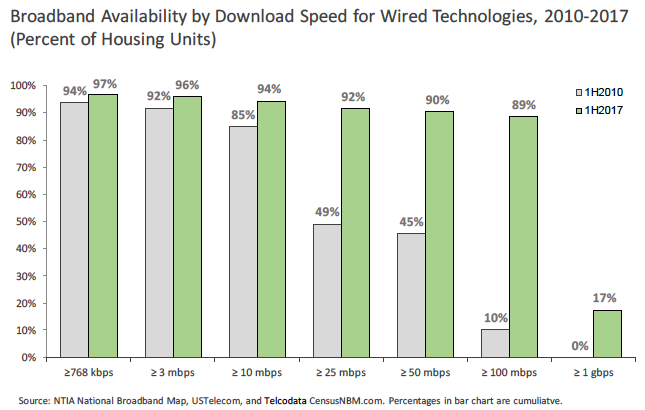November 30, 2018
U.S. broadband providers continue to deploy and upgrade networks to bring American consumers ever-faster service and more competitive choice, according to a new USTelecom and CensusNBM analysis of Federal Communications Commission (FCC) data reflecting broadband deployment as of mid-year 2017. The USTelecom research demonstrates that broadband capital investment, amounting to $76 billion in 2017 and more than $1.6 trillion since 1996, generates real communications infrastructure improvements that can yield additional economic benefits for American consumers and businesses.

In just a year and a half, from the end of 2015 to mid-2017, U.S. fiber deployment grew from 21 percent to 29 percent of homes and competitive availability of wired broadband at 25 megabits per second (mbps) download and 3 mbps upload increased from 31 percent to 55 percent. At lower speed tiers, and if fixed wireless is included, competitive availability is even greater: 77 percent at 10 mbps download and 1 mbps upload; and 91 percent at any speed. By mid-2017, broadband at 100 mbps download was available to 89 percent of Americans, compared to 10 percent in 2010. Moreover, fiber deployment and competitive availability of broadband at higher speeds continue to grow rapidly today, driven by competitive upgrades.
Meanwhile, gaps between non-rural and rural broadband availability are declining. From the end of 2015 to mid-2017, the difference between non-rural and rural deployment of fixed broadband at 10 mbps download and 1 mbps upload narrowed from 20 percent to 14 percent. As with deployment more generally, rural broadband gaps continue to narrow.
While progress remains strong, the need to upgrade broadband network speed and quality is constant and significant challenges remain, especially in further narrowing rural broadband gaps. Therefore, it will remain imperative for policymakers to maintain an investment-friendly environment for broadband deployment, including providing additional financial support in areas that need it. Governments should target support to specific areas where the economics do not support deployment or upgrades, and funding must be dedicated and direct, using a mechanism like the Connect America Fund. Policies must also be sufficiently flexible to allow for the most cost effective solutions and must avoid funding wasteful overbuilding of existing facilities.
For a detailed analysis, please see the full research brief.